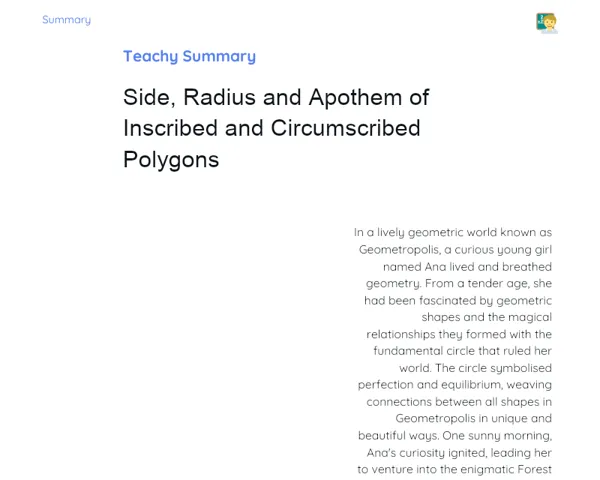Summary Tradisional | Complex Numbers: Conjugate
Contextualization
Complex numbers are an extension of real numbers and incorporate an imaginary component. While real numbers can be plotted on a straight line, complex numbers are graphed on a two-dimensional plane known as the complex plane. Every complex number has a real part and an imaginary part, expressed as a + bi, where a is the real component and bi is the imaginary component, and i is the imaginary unit defined as the square root of -1. This concept enables complex numbers to solve equations lacking real solutions, greatly expanding the domain of mathematics and its practical usage.
Within this framework, understanding the conjugate of a complex number is crucial. The conjugate of a complex number z = a + bi is represented as z̅ and is obtained by changing the sign of the imaginary part, which gives z̅ = a - bi. This operation proves useful in various scenarios, particularly in simplifying complex algebraic expressions and solving equations. Additionally, the conjugate exhibits significant mathematical properties that find practicality in fields like electrical engineering and physics. Grasping the concept of the conjugate and its applications is vital for advancing in more intricate studies, whether in mathematics or other scientific areas.
To Remember!
Definition of the Conjugate of a Complex Number
The conjugate of a complex number is a key operation that changes the sign of the imaginary part. For example, if we have a complex number in the format z = a + bi, where a is the real part and bi is the imaginary part, the conjugate is denoted by z̅ and is calculated as a - bi. This straightforward operation has noteworthy importance in areas such as algebra and complex analysis.
A defining feature of the conjugate is its reflection across the real axis on the complex plane. While the real part remains unchanged, the imaginary part inverts its sign. This symmetry with respect to the real axis makes the concept of the conjugate quite handy in a variety of mathematical tasks, including simplifying complex fractions and solving equations.
Moreover, the conjugate possesses mathematical properties that aid in calculations. For instance, the product of a complex number and its conjugate yields a real number, specifically the square of the modulus of the complex number. This particular property is especially useful when handling expressions with complex numbers.
-
The conjugate of z = a + bi is z̅ = a - bi.
-
The conjugate reflects the complex number across the real axis.
-
The product of a complex number and its conjugate gives a real number.
Properties of the Conjugate
The conjugate of complex numbers features numerous properties with practical implications. One of the basic properties is that the conjugate of a conjugate of a complex number will return the original complex number. Formally, this is captured as (z̅)̅ = z. This property is quite intuitive; flipping the sign of the imaginary part twice returns it to its original state.
Another essential property states that the sum of a complex number with its conjugate results in twice the real part of the complex number. This is mathematically represented as z + z̅ = 2a, where a signifies the real part of z. This property is often utilised in simplifying algebraic expressions featuring complex numbers.
Additionally, the product of a complex number and its conjugate equals the square of its modulus, formulated as z * z̅ = a^2 + b^2, where a and b are the respective real and imaginary components of z. This characteristic is fundamental in numerous calculations, particularly when a real number is needed from a complex expression.
-
The conjugate of the conjugate of a complex number returns the original complex number.
-
The sum of a complex number and its conjugate results in twice the real portion of the complex number.
-
The product of a complex number and its conjugate equals the square of the modulus of the complex number.
Applications of the Conjugate
The conjugate of complex numbers has various practical applications across different scientific and engineering fields. A common use is in simplifying complex fractions. When faced with a fraction where both the numerator and denominator are complex, multiplying both by the conjugate of the denominator is an effective strategy to eliminate the imaginary part of the denominator, thus rendering a simpler expression.
Another significant application lies in solving polynomial equations that have complex coefficients. Frequently, leveraging the conjugate can ease the process of determining the roots of these equations, which proves particularly advantageous in abstract algebra and complex function theories, where comprehension and manipulation of complex numbers is fundamental.
Furthermore, in disciplines such as electrical engineering and physics, using the conjugate is essential for analysing and tackling problems related to electrical circuits and signals. For instance, in AC (alternating current) circuit analysis, complex numbers and their conjugates represent and assist in handling impedances and other electrical quantities.
-
The conjugate is instrumental in simplifying complex fractions.
-
It assists in solving polynomial equations that include complex coefficients.
-
Utilised in evaluating electrical circuits and signals within electrical engineering.
Practical Examples and Problem Solving
To strengthen the grasp of the conjugate of complex numbers, practicing with examples and tackling problems is essential. Take the complex number z = 3 + 4i. The conjugate of this number is z̅ = 3 - 4i. If we calculate the product of z and z̅, we find: z * z̅ = (3 + 4i)(3 - 4i) = 3^2 - (4i)^2 = 9 - 16(-1) = 9 + 16 = 25. As anticipated, the outcome is a real number.
Another practical exercise involves validating the properties of the conjugate. Suppose we have z = 5 - 2i. The conjugate would be z̅ = 5 + 2i. The sum z + z̅ comes to 5 - 2i + 5 + 2i = 10, which indeed reflects twice the real part of z. The product z * z̅ results in (5 - 2i)(5 + 2i) = 5^2 - (2i)^2 = 25 - 4(-1) = 25 + 4 = 29, confirming the square of the modulus of z.
Practising real-world problems solidifies theoretical concepts and illustrates the practical applications of the conjugate. Moreover, working through various examples allows one to detect patterns and boosts self-assurance when employing complex numbers in different mathematical situations.
-
Example of conjugate: z = 3 + 4i, z̅ = 3 - 4i, and the product z * z̅ = 25.
-
Verification of properties: z = 5 - 2i, z̅ = 5 + 2i, z + z̅ = 10, z * z̅ = 29.
-
Working on practical problems reinforces theoretical understanding.
Key Terms
-
Complex Number: A number in the form a + bi, where a is the real part and bi is the imaginary part.
-
Real Part: The portion a of a complex number a + bi.
-
Imaginary Part: The portion bi of a complex number a + bi.
-
Imaginary Unit: Denoted as i, defined as the square root of -1.
-
Conjugate of a Complex Number: For z = a + bi, the conjugate is z̅ = a - bi.
-
Modulus of a Complex Number: The magnitude of z = a + bi, calculated as √(a^2 + b^2).
Important Conclusions
In this lesson, we explored the concept of complex numbers and their conjugate, which is foundational for understanding advanced mathematics operations. We discovered that the conjugate of a complex number alters the sign of the imaginary part, leading to crucial properties that ease various calculations and simplifications. We also examined the practical applications of the conjugate in fields like electrical engineering and physics, underscoring its real-world significance.
Recognising the properties of the conjugate—such as how the sum of a complex number with its conjugate results in twice the real part, and the product yields the square of its modulus—is vital for working with complex expressions and solving polynomial equations. These properties not only streamline calculations but also serve as valuable tools in numerous practical and theoretical applications.
Lastly, through practical examples and problem-solving, we solidified our theoretical understanding and acknowledged the importance of knowledge surrounding complex numbers and their conjugates. This knowledge is a critical foundation for more advanced studies in mathematics and other sciences that employ complex numbers in their analyses.
Study Tips
-
Practice solving problems that involve complex numbers and their conjugates, focusing on various operations and simplifications.
-
Review the properties of the conjugate and seek to apply them in real-world contexts to enhance understanding of their usefulness and applications.
-
Investigate the applications of complex numbers and their conjugates in fields such as electrical engineering and physics to see how this knowledge is relevant in practice.



